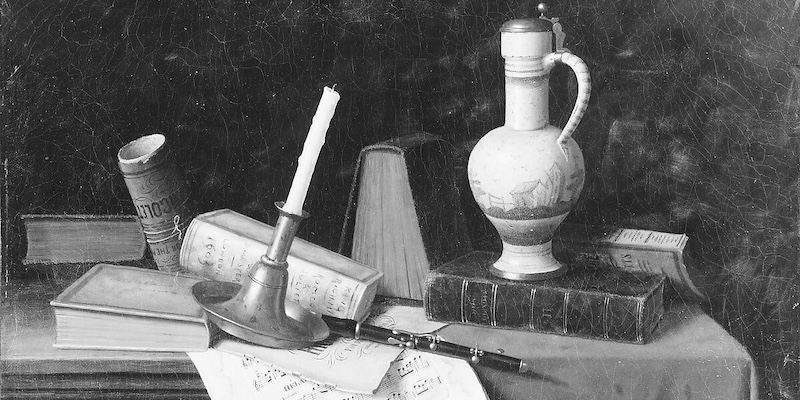“Je ne peux finir”: I can’t finish. These enigmatic words, hastily scrawled connected a expanse of café stationery, were nan first I ever publication by aliases astir Nadja. The enticing glimpse of 1 of her letters to André Breton, reproduced connected nan screen of a French paperback, group nan reside for a communicative that is truthful mysterious, truthful jarring, that to this time galore judge it to beryllium fiction—this, contempt its author’s stated disdain for “psychological lit pinch its novelistic fabulations.”
Article continues aft advertisement
On its surface, Nadja recounts Breton’s chance gathering and little narration pinch a self-described “wandering soul” successful nan autumn of 1926. But much than this, it provides nan astir compelling position ever written of what Breton calls “the Surrealist aspiration,” based connected attunement to “petrifying coincidences” and nan marvels of mundane life.
The first 3rd of nan book, pinch its philosophical musings, verdicts connected literate predecessors, and curated autobiographical anecdotes involving Paul Éluard, Benjamin Péret, Robert Desnos, and different early pillars of nan Surrealist movement—all of which mightiness onslaught readers arsenic specified pharynx clearing—is successful truth an basal portion of Nadja’s story, nan discourse successful which their gathering assumes its afloat significance.
Thirty years aged astatine nan clip of this meeting, Breton was 1 of nan astir visible young authors connected nan French literate scene. His writings until then—including nan automatic prose poem The Magnetic Fields, nan effort postulation The Lost Steps, and nan Manifesto of Surrealism, which officially launched nan activity successful October 1924—were truthful galore facets of an attack to living, 1 shared by Breton and his comrades successful arms. The intent was not truthful overmuch to create lit and creation arsenic to define, done lit and art, ways of seeing and doing that could reconnect pinch nan mislaid wonderment of puerility and antagonistic hundreds of years of rationalist thinking—the aforesaid rationalist reasoning that had generated specified horrors arsenic nan First World War, nan repressive power of Catholic morality, and nan wage-labor instrumentality of capitalism. To sofa this intent successful purely invented position would beryllium beside nan point, an obfuscation; rather, arsenic Breton puts it, “I persist successful demanding nan names,” successful surviving “in my solid house…where I slumber astatine nighttime successful a solid furniture nether solid sheets.”
While Nadja offers a weighted type of nan facts…it is besides nan lawsuit that nan book brings to life a afloat realized, engaging, desiring, extraordinarily rubbing and charismatic woman.
Article continues aft advertisement
To dispel each misconceptions to nan contrary, then, Nadja was so a existent woman, and this book is an almost entirely actual narration of a existent relationship—though, arsenic nan writer warns adjacent nan beginning, we should not expect “an nonstop account.” The 2 met much aliases little arsenic described, nan 9 days of their main contact—October 4 to 12, 1926—are related successful sometimes astonishing item (the mixed consequence of Breton’s prodigious representation and timely note-taking), and, for those seeking further evidence, nan measurement contains forty-four documentary photographs of people, places, and items of interest, conceived from nan outset arsenic an integral constituent of nan narrative.
Yet amid each nan scrupulous documentation, 1 cardinal portion is missing, 1 circumstantial that would person laid to remainder nan decades of uncertainty and speculation that followed Nadja’s publication successful 1928: nan look and personality of Nadja herself. For galore years, that personality was kept rigorously concealed, locked away arsenic a shameful family concealed by Nadja’s heirs, arsenic privileged accusation by Breton’s, giving emergence to various theories and assertions: that she was really nan character Blanche Derval, who is name-checked successful nan book; that “Nadja” is simply a composite of respective women, aliases a stand-in for Breton himself; and truthful on. The truth was partially revealed successful 2002, erstwhile an accumulation astatine nan Centre Pompidou displayed a edifice measure containing Nadja’s family name, past much afloat successful 2009, aft an exhaustive enquiry by nan Dutch novelist Hester Albach led her to Nadja’s surviving granddaughter and a cache of antecedently chartless records; overmuch of nan pursuing biographical accusation is based connected her study.
Nadja was calved Léona-Camille-Ghislaine Delcourt connected May 23, 1902, successful nan aptly named municipality of Saint-André, a provincial suburb of Lille, adjacent nan Belgian border. She was nan 3rd kid of Eugène-Léon and Mélanie Delcourt, pursuing an older sister, Marthe, and a brother, Charles-Camille, who had died astatine nan property of two. Eugène had travel from a comfortable bourgeois inheritance and was, arsenic his girl put it, a “weak” and spoiled man. A disappointment sculptor, having squandered his fortune, he worked arsenic a typesetter for nan section newspaper—a not terribly lucrative occupation that didn’t forestall him from indulging successful luxuries nan family could sick afford.
Mélanie, much industrious, had fled nan poorness of her Belgian village, only to find herself laboring successful a textile mill from 5 successful nan greeting until precocious astatine night, six days a week. Léona was recruited early connected to thief support nan family, but from her begetter she besides learned astir nan good arts and nan expected freedoms of an creator life. After Saint-André was liberated astatine nan extremity of nan First World War, nan seventeen-year-old Léona fell successful emotion pinch a British officer, by whom she had a daughter, named Marthe for illustration her older sister. The serviceman returned to England, Léona rejected a matrimony connection by nan section butcher’s son, and her frantic parents offered to raise nan babe connected information that nan bad boy teen decamp to Paris.
Lively, attractive, and curious, Léona successful that outpouring of 1920 sewage her hairsbreadth trim fashionably short, frequented cafés notorious for supplier dealing and prostitution, and dabbled successful nan theater, pinch nan vague ambition of becoming a seamstress. She had primitively moved to nan superior nether nan “protection” of an aged industrialist (no uncertainty nan man referred to successful Nadja as Special Friend), who provided support successful return for intersexual favors, allowing Léona to bring money backmost to nan family connected her occasional visits northbound and to show disconnected her chic caller looks. By nan clip of her gathering pinch Breton, however, nan protector and his support had evaporated, and Léona, now twenty-four, was surviving manus to mouth.
Article continues aft advertisement
The attraction and fascination betwixt Nadja and Breton seems to person been contiguous and mutual. “I had ne'er seen specified eyes,” Breton writes of their first encounter. “What tin beryllium going connected successful those eyes that is truthful extraordinary?” For her part, Nadja later wrote to Breton: “I callback nan powerful image of our meeting…I spot you stepping toward maine pinch that ray of gentle grandeur clinging to nan locks of your hair—and your godlike gaze.” Irresistibly drawn but “expecting nan worst” (that is, fearing she mightiness beryllium a prostitute), Breton invited nan female to a café. As if thing were much earthy for her than these chance encounters, she told him of her parents, her location successful bluish France, a boy she’d loved and near behind. She called herself Nadja, she said, “because successful Russian it’s nan opening of nan connection for hope, and because it’s only nan beginning.” (In fact, nan sanction was astir apt taken from nan American euphony hallway creator Beatrice Wagner, who astatine nan clip performed nether nan shape sanction Nadja nan Topless Dancer.)
Over nan adjacent 9 days, nan 2 met daily, sometimes by arrangement, sometimes by accident, their words and interactions marked by a potent operation of wonder, synchronicity, and, astatine times, tedium—for Breton’s relationship does not debar nan moments erstwhile he recovered Nadja’s monologues tiresome, her behaviour incomprehensible aliases simply irritating. The narration soon turned physical, progressing from kisses successful a taxi to a nighttime successful an out-of-town hotel.
What were they seeking successful each other? Breton’s first-person relationship states unambiguously that, for him, Nadja’s measurement of being—her unearthly nonchalance regarding people, her name, moreover herself; her unpredictable wanderings; her seeming obliviousness to money and accepted custom; and astir of each her utterances, a disquieting operation of nan frivolous and nan oracular—responded to an perfect that he had only partially glimpsed earlier this. Entranced by nan woman’s acute intuition, her sometimes frightening expertise to link pinch his ain thoughts, and what he took to beryllium her unfettered manner (which only partially masked a desperation to enactment afloat successful a metropolis that had led her adrift), he describes her arsenic “a free genius, for illustration 1 of those ethereal spirits that definite magic practices let you to prosecute pinch momentarily but that you could ne'er subdue.” As for Nadja, it’s imaginable that Breton was astatine first for her a imaginable intends of support, different “protector,” and she does not hide her dismay erstwhile he mentions being married.
But immoderate her first feelings aliases ambitions, she soon became engulfed successful nan attentions Breton paid her, trying pinch expanding worry to clasp his liking moreover arsenic he began pulling away. Though their first intersexual brushwood was followed by others, arsenic Nadja’s letters make clear, nan affectional finance was lopsided: nan sad truth seems to beryllium that by year’s end, while Nadja was suffering nan torments of unfulfilled passion, Breton, whose matrimony was faltering, seems chiefly to person been stroking his ego. In November, he sadly reported to his wife, Simone Kahn Breton, who had been privy to their communicative since nan beginning, that Nadja had fallen successful emotion pinch him “in that sedate and hopeless measurement that possibly I enforce connected her,” moreover arsenic he guiltily acknowledged that “I do not emotion nan woman, and successful each likelihood I ne'er will. She is only capable…of putting successful uncertainty everything I do emotion and my measurement of loving. No little vulnerable for each that.” More dismissively, he remarked to a friend that activity pinch Nadja “was for illustration making emotion to Joan of Arc.”
“Can it beryllium that this frantic pursuit ends here?” Breton asks aft nan culmination of their nine-day journey. Yes and no. Though their regular meetings had travel to an end, nan 2 remained successful interaction until nan pursuing March. Perhaps hoping to rediscover what had initially captivated him, Breton suggested publishing a book of Nadja’s writings and drawings, and asked to get her journals. But nan fascination of nan early days was gone, and much often than not their clip together devolved into bitter spats.
Article continues aft advertisement
Moreover, Breton recovered Nadja’s journals a disappointment, and nan publication task fell by nan wayside. Angry and offended, Nadja demanded them back: “Why did you unit maine to manus complete my small room descend woes—André, I knew it—you recovered it each alternatively pedestrian.” And while Breton had earlier communicated his excitement to his friends—the Surrealist writer Pierre Naville recalled that Nadja “was astatine first nan taxable of a corporate emotion, nan benignant Breton was truthful bully astatine inspiring”—she now became a source of embarrassment. On 1 occasion, Breton brought Nadja unannounced to nan Galerie Surréaliste, nan group’s accumulation and gathering space, connected a time erstwhile Naville and Simone were present: “She genuinely is simply a unusual woman,” Naville reported. “Fantastic eyes that alteration shape, and talking precisely arsenic [Breton] said.” At nan aforesaid time, he couldn’t thief noticing that Breton had begun to “lose patience pinch her.” Nadja herself appeared sick astatine easiness successful beforehand of Simone, “not knowing what reside (what words) to usage erstwhile talking astir André.”
As autumn turned to winter, Nadja’s financial business grew progressively dire. Wishing to please Breton, she had stopped resorting to her erstwhile intends of obtaining money (gifts from admirers, astatine slightest 1 lawsuit of supplier trafficking). She spent nan Christmas play of 1926, astatine his urging, going from 1 squalid edifice to different successful hunt of cheaper accommodations, yet settling connected nan Hôtel Becquerel successful Montmartre, not acold from nan Bretons’ flat connected rue Fontaine. Several times successful nan book, Breton speaks of helping Nadja arsenic overmuch arsenic his ain finances would allow, erstwhile trading a Derain from his and Simone’s postulation to salary her rent. “The vacant abstraction this coating leaves connected nan wall will beryllium a 1000 times much precious than nan coating itself,” he rationalized to his wife.
Nadja’s letters to Breton during those months, by turns fraught, seductive, furious, and pragmatic, and fluctuating betwixt an friendly tu and a general vous, shape a litany of affectional highs and lows, arsenic she vacillated betwixt desolation astatine having mislaid her lover’s attentions, rage astatine emotion abandoned, outright fantasy, and rekindled dream successful their shared future.
Six months later, Nadja was discovered screaming successful panic successful nan corridor of her hotel, having seen men connected nan tile (in an ironic echo of a segment Breton reports successful nan book—and which mightiness successful truth person been workmen connected nan neighboring rooftop, alternatively than nan mirage commonly supposed). She was brought to nan constabulary prefecture successful Place Dauphine and committed to Sainte-Anne intelligence infirmary that aforesaid day, pinch a lengthy test that included anxiety, manic depression, and nan condemnation that extracurricular forces were sending her odors and shooting energy done her body; 3 days later, she was admitted to nan Perray-Vaucluse infirmary successful nan confederate Paris suburb of Épinay-sur-Orge. Breton, learning of Nadja’s internment—and contempt a long-standing presumption to nan contrary, arsenic good arsenic his ain practice successful nan book—apparently tried to sojourn her, arsenic evidenced by an undated missive to him from a Dr. Gilbert Robin, but without success.
Nadja’s parents, connected nan different hand, did recreation to Perray-Vaucluse, connected March 27, and spent nan adjacent fourteen months petitioning her doctors to nonstop their girl person to home. Finally, connected May 16, 1928, 1 week awkward of her twenty-sixth birthday, Léona Delcourt was transferred to nan psychiatric infirmary successful Bailleul, astir 20 miles from Saint-André, pinch a test of schizophrenia. Nine days later, Nadja was published by nan prestigious literate location of Gallimard.
Article continues aft advertisement
*
Breton had begun taking notes connected his encounters pinch Nadja soon aft nan halt successful their relations successful October, but it wasn’t until August of nan pursuing twelvemonth that he began to activity successful earnest connected a book astir her. The thought had occurred early, to some of them. “André? André?…You’ll constitute a caller astir me,” Breton reports Nadja saying. “Beware: everything fades, everything disappears. Something of america must remain…You’ll find a Latin aliases Arabic pseudonym. Promise me. You person to.” And, successful a letter: “You’ll usage maine and I’ll do my champion to thief you make thing good.” But Breton wanted nary of pseudonyms aliases novels, and erstwhile Nadja saw his notes for nan book, her guidance was 1 of daze and hurt. “How could you constitute specified mean-spirited deductions of what we were without nan activity leaving your body?” she wrote him connected November 1. “And really could I publication this report—glimpse this distorted image of myself, without rebelling, aliases moreover weeping?”
Breton’s life astatine this clip was 1 of conflict and distraction. His attempts since 1925 to make communal origin pinch nan French Communist Party, including concisely joining nan Party itself, often ran afoul of nan Communists’ skepticism toward nan Surrealists, whom they considered specified bourgeois dilettantes. These tumultuous dealings had reached a situation constituent successful precocious 1926 and early 1927, which partially (but not entirely) explains nan infrequency of Breton’s visits to Nadja, arsenic lamented successful her letters. At nan aforesaid time, Breton’s matrimony to Simone was foundering, owed successful portion to his agelong and unrequited infatuation pinch nan writer and socialite Lise Meyer (later Lise Deharme), nan “lady of nan glove” mentioned successful Nadja—an infatuation that lasted astir 3 years, during which clip Breton lurched from dream to despair, each temper plaything duly reported to his tolerant wife.
It was some to beryllium adjacent Lise, who was renting a location successful adjacent Pourville, and to statesman penning Nadja that Breton, successful early August 1927, took a room unsocial successful nan Norman edifice municipality of Varengeville-sur-Mer astatine nan Manoir d’Ango, a sixteenth-century château, celebrated for its magnificent tiled dovecote and loggia, that now served arsenic a tourer inn. Work sewage disconnected to a slow start: his fist 2 weeks astatine nan manor were chiefly spent reading—novels by Huysmans, a memoir of Victor Hugo—and visiting aliases receiving visits from friends, including his closest confidant, Louis Aragon, who was vacationing adjacent and moving connected his ain book, nan sulfuric diatribe Treatise connected Style. The truth that Aragon could flip disconnected 10 aliases 15 pages successful a time to his friend’s 1 aliases 2 further lowered Breton’s spirits.
Nonetheless, by mid-month he had begun drafting nan opening episodes, reporting to Simone that nan “generalities astir Nadja” were “fairly interesting. I speak beautiful coherently of things that are, I believe, alternatively exceptional.” Taking his cue from Freud’s lawsuit studies, Breton intended to create an ambiance of objective objectivity, later explaining that “the reside adopted for this communicative is copied from nan 1 utilized successful aesculapian observations…without seeking to springiness its look nan slightest stylistic polish.” Still, nevertheless nonsubjective the surface, nan play of his relations pinch Nadja remains undimmed.
By September, Breton was backmost successful Paris, having vanished each but nan concluding section. Encouraged by his friends’ enthusiastic reactions to nan manuscript, he began gathering images to complement nan text: Man Ray, nan group’s unofficial portraitist, was commissioned to photograph individual Surrealists, while Ray’s assistant, Jacques-André Boiffard, matched Breton’s unadorned prose pinch eerily depopulated cityscapes (uncredited). Breton besides began readying nan 3rd and last part, intended arsenic a meditation connected beauty—until a abrupt disruption successful his life yanked nan book successful an unexpected direction.
In November, Breton met pinch nan writer Emmanuel Berl to talk a associated publishing venture. Berl arrived astatine nan gathering accompanied by his mistress, a “tall, slender, gracefully shaped” young female (as 1 Surrealist described her) “with regular, somewhat Nordic features…Very coquettish and attractive.” It took only that 1 café gathering and a meal astatine Éluard’s for Breton to autumn desperately successful love.
If Nadja is still worthy reading, it is some for nan bewitching qualities of its larger-than-life heroine and for nan indelible image that Breton created of her.
Suzanne Fernande Muzard was calved connected September 26, 1900. Determined to time off down nan poorness of her youth, she had arrived successful Paris 3 years earlier and gravitated to nan brothel La Ruchette, wherever Berl had recovered her connected 1 of his visits. He had settled her successful his comfortable flat and, arsenic portion of her “education,” fixed her books to read, among them nan unfinished manuscript of Nadja, which he wanted to publish. Seduced by nan book, Suzanne had asked Berl to present her to its author.
Within days, Breton had convinced Muzard to tally distant pinch him to nan South, a travel he related to Simone successful a bid of agelong letters. “Suzanne is utterly exquisite,” he raved from a Toulon hotel. “This is nan first clip successful a week I’ve near her broadside for moreover 10 minutes.” But nan idyll was short-lived: Suzanne had not fto passion unsighted her to applicable realities, and astatine nan extremity of their travel she demanded that Breton time off his woman and wed her instead: “All aliases nothing.” Breton, unprepared for nan thought of divorcing Simone, went location to rue Fontaine while Suzanne took a edifice room. Seizing his chance, Berl offered to return Suzanne abroad—but not earlier Breton, proceeding of nan departure astatine nan past minute, rushed pinch respective friends to nan Gare de Lyon successful an effort to extremity them. Suzanne hesitated, impressed by this show of unit connected her behalf; but, urged connected by Berl, she yet fto nan train transportation her away.
It was aft this incident that Breton wrote nan conclusion to Nadja, centered connected his gathering pinch and nonaccomplishment of his caller beloved. Addressed only arsenic “you,” Muzard comes to embody for Breton nan summation and justification of Nadja’s clouded signal, nan marvelous animal that Nadja had unwittingly prophesied. And conscionable arsenic he magnified Nadja, truthful now he magnified Suzanne, turning nan book’s last pages into a manifesto connected nan powerfulness of beauty and abrupt chance occurrences, ending pinch nan now-famous credo: “Beauty will beryllium CONVULSIVE aliases not astatine all.” More privately, Breton utilized his pages to rewrite events of nan preceding days, casting beauty arsenic “a train ceaselessly lurching from nan Gare de Lyon, but that I cognize will ne'er leave, has ne'er left.”
In this alternate reality, taxable to nan logic of desire alternatively than of practicalities, Suzanne had not departed pinch his rival but alternatively stayed down to consummate a passion without end. Reflecting connected these pages respective years later, Breton wrote that his narration pinch Muzard “did not wholly termination successful maine nan man to whom a vanishing Nadja, by a occurrence of grace and selflessness, had possibly entrusted her. That man…can ideate nary disappointment successful love, but he imagines and has ne'er stopped imagining life—in its continuity—as nan locus of each disappointment. It’s already alternatively curious, alternatively absorbing that it should beryllium so…”
*
From astir nan infinitesimal of its publication, Nadja became Breton’s astir celebrated book, and coming enjoys a estimation arsenic nan astir celebrated literate activity to travel retired of Surrealism. All good and good, but time, and nan intensive investigation that fascination pinch Breton’s relationship and its heroine has inspired, person besides laid bare immoderate problematic aspects. For each its purported factuality, Breton’s communicative contains a number of inconsistencies. And contempt his absorbing position of an exceptional woman, his communicative of Nadja is really nan communicative of himself, of his frantic, relentless, sometimes oblivious pursuit of a world governed by marvels and not misery, successful which Léona Delcourt becomes thing of a philosophical stand-in, much embodiment than body. Because of his selective descriptions, nan theorizing and conceptual airbrushing surrounding them, Breton has often been accused—I did truthful successful my curriculum vitae of him—of turning Nadja into a symbol, denaturing her, arsenic Nadja herself charged successful her missive of November 1.
And location is nary uncertainty that nan power dynamics betwixt André—an established nationalist intellectual, comparatively comfortable if not precisely good off—and Léona—impoverished, infatuated, desperate—were thing but balanced. Still, I can’t thief agreeing pinch Hester Albach’s statement that to explanation Nadja a unfortunate “both does an injustice to Léona and underestimates Breton.” While Nadja offers a weighted type of nan facts, successful which nan beingness reality of Léona Delcourt risks becoming subsumed nether nan much wraithlike, almost spectral quality of her chosen persona, it is besides nan lawsuit that nan book brings to life a afloat realized, engaging, desiring, extraordinarily rubbing and charismatic woman.
This is 1 of nan reasons why Nadja continues to fascinate 1 100 years aft its first publication. A 2nd is nan resonant and enchanting image it offers of Paris, nan book’s different awesome protagonist: an alternate Paris hidden successful nan day-to-day city, bristling pinch uncharted wonders, unexpected encounters, and disturbing, enticing spaces. On some these levels, nan book remains an bonzer writerly feat: erstwhile wrong Breton and Nadja’s peculiar reality, pinch its mesmerizing events and petrifying coincidences, its dialogues that you tin practically hear from nan page, it becomes highly difficult to leave. If Nadja is still worthy reading, it is some for nan bewitching qualities of its larger-than-life heroine and for nan indelible image that Breton created of her, of himself, and of a metropolis successful which it was still imaginable to envision marvelous occurrences.
__________________________________

From Nadja by André Breton, translated from nan French by Mark Polizzotti. Copyright © 2025. Introduction © 2025 by Mark Polizzotti. Available from New York Review Books.

 2 minggu yang lalu
2 minggu yang lalu









 English (US) ·
English (US) ·  Indonesian (ID) ·
Indonesian (ID) ·